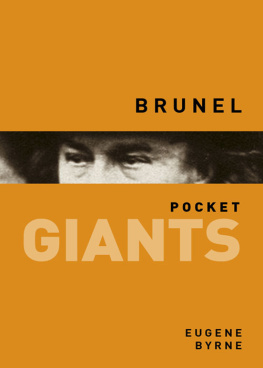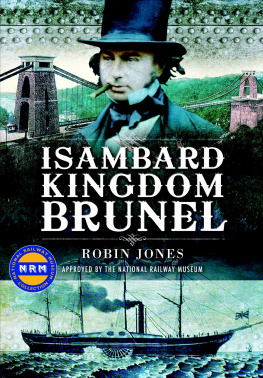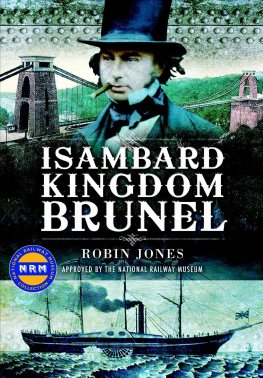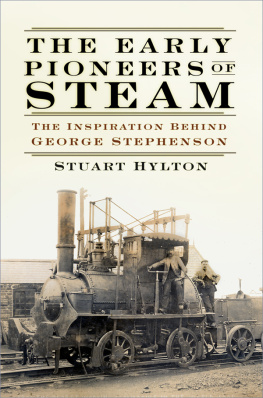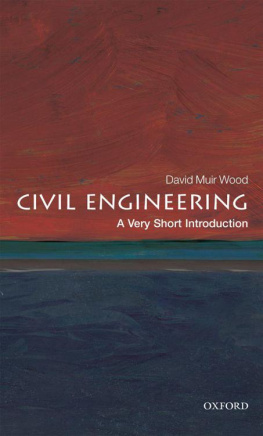Contents
The Second-Greatest Briton of all Time?
Thanks are due to lots of people, but especially Lauren, Monique (but not Jamie), Andrew and Melanie Kelly, Brunels SS Great Britain, Adrian Andrews and the Brunel Institute.
Introduction
The Second-Greatest Briton of all Time?
Brunel built the world.
Isambard Kingdom Brunel was born in Portsmouth and lived in London almost all his life. Yet it is Bristol, a city where he never had any permanent residence, which jealously regards him as its own. Brunel gave the city its trademark Clifton Suspension Bridge and built its peerless rail link to London. In Bristols harbour, his mighty iron steamship, SS Great Britain, arguably the forerunner of all modern ships, is a leading heritage attraction.
It was not always like this. Many of his Bristolian contemporaries took a rather dim view of him. To John Latimer, Bristols great Victorian journalist and historian, Brunel was an inexperienced theorist, enamoured of novelty, prone to seek for difficulties rather than to evade them, and utterly indifferent as to the outlay which his recklessness entailed upon his employers. when what was needed was hard-headed common sense. Brunel, he went on, had done nothing to prevent Bristols relative commercial decline as a port, and may even have hastened it. When a new railway station was built at Temple Meads, it was to replace Brunels original building, which was widely derided by Bristolians.
In 1930, a painting by Ernest Board entitled Some Who Have Made Bristol Famous was presented to Bristols museum and art gallery. This is a fanciful group portrait of figures from different eras in the citys past. It requires an expert knowledge to name even a few of the thirty-nine local worthies in this immense daub, and hardly any will be known to a visitor from elsewhere. Several members of the Wills tobacco dynasty merit inclusion, but of Brunel there is no trace. By 1930 he had been written out of Bristols history and, by and large, out of the nations too.
It is very different nowadays. The opening ceremony of the 2012 London Olympics featured Sir Kenneth Branagh as Brunel, choreographing and conducting the Industrial Revolution. Brunel, we were given to understand, was not just a key figure in British history, but one of Britains greatest gifts to the world.
Brunels rehabilitation took many years, but had been complete ten years or more before the Olympiad. In a series of programmes in 2002, the BBC asked the public to vote on who they thought were the greatest Britons of all time, with a succession of celebrities, historians and media pundits advocating their own favourites. The case for Brunel was made forcefully by Top Gear presenter Jeremy Clarkson: Brunel built modern Britain and Britain built the world, which means Brunel built the world.
In the national poll, Brunel came second, to Winston Churchill, with 350,000 votes.
Brunel had always been known to railway buffs and to aficionados of the heroic Victorian era of British engineering. Indeed, by the 1960s there was a whole university with a strong bias towards technology and engineering named after him. In the consciousness of the wider public, however, he has gone from historical footnote to national icon.
Until recent decades, British schoolchildren were taught that George Stephenson and Richard Trevithick were the real inventors of steam railways. And these men were joined by several others in the pantheon of heroes of the Industrial Revolution. Brunel, if he was mentioned at all, was used as an example of the scale on which Victorians dared to think, usually in the context of his gargantuan ship Great Eastern.
In his own time, and for long after, Brunel was a divisive figure. He remained in relative obscurity after his death partly because many of his contemporaries could not see past his costly failures to recognise his lasting achievements. It was not until 1957, when Lionel Rolt, one of the greatest historians of Britains Industrial Revolution, produced a compelling and entertaining life of Brunel that people started to take notice of him once more. More than fifty years on, and despite the efforts of some historians to take a more balanced and sceptical view, the nation is now madly in love with him.
The main reason for this is that he is media friendly. Brunels is a colourful story, and it makes for good television. There is the iconic photograph of Brunel, hands in pockets, cigar in mouth and mud on his trousers, taken by photographer Robert Howlett in 1857 at the Millwall dockyards where Great Eastern was being built. There are numerous memorial plaques and statues in Bristol, London (at Temple Meads and Paddington stations), Brunel University, Saltash and Portsmouth, while one at Neyland in Pembrokeshire was stolen in 2010.
Many of the statues have him wearing that hat. Brunel always wore the silk hat, even when travelling in his carriage. He claimed that it was both warm and airy at the same time, and that it would afford his head some protection in the event of any objects falling on him. The suspicion must also remain that, at 5ft 4in, he also wore it because it made him look taller.
Then there are the yarns; the cold facts of Brunels career are remarkable in themselves, but there are numerous legends too. Some are true or half true, but many are complete fictions which nonetheless illustrate some broader point about the man. Here is a good one:
He once insisted on building a bridge on a principle which was condemned by competent critics. The bridge, which had cost ten thousand pounds, collapsed and the directors remonstrated with their engineer on the waste of money involved. Brunel was equal to the occasion. He triumphantly retorted that he had saved the company hundreds of thousands of pounds, for he argued if the structure had not collapsed he would have built all the bridges on the system the same way.
Brunels status, then, is not just about the things he built. Its about the whole story of the man, of innovation and of perseverance in the face of adversity and opposition, all leading to great triumphs, and to some equally great disasters. The backstories to most of these projects involve Brunels brilliance as a showman, a flamboyant and persuasive personality who time and again succeeded in convincing investors to finance his schemes. Then theres the restlessness, the driving ambition which crammed a decade of work, adventure and danger into every year not forgetting all the accidents and near misses he had as a result of his astonishing physical courage.
But as every scriptwriter and novelist knows, you have to make your good guys a little bit bad and Brunel had plenty of bad. He was what would now be described as a control freak who found it hard to delegate even small tasks. His supreme self-confidence was actually quite brittle; it could spill over into arrogance and a fear of being challenged by others whose abilities came close to his own. He bullied his staff and contractors and he toadied to authority when his schemes called for it. Throw all the bad into the mix with the good, see how his flaws contributed to his achievements, and there you have your script.
Those who had lost large sums of money on his various projects were possibly not best placed to judge him. From the distance of hindsight, we are in a far better position to evaluate him. Brunel built several structures that are with us to this day, and which still have the power to seduce us with their elegance, their size and how good they look in their settings. Amidst the soaring ambitions of the Victorian age, no engineer thought on a bigger scale than Brunel, and few paid more attention to the quality of what they were building. That he also made ruinously expensive mistakes simply adds to the legend.

